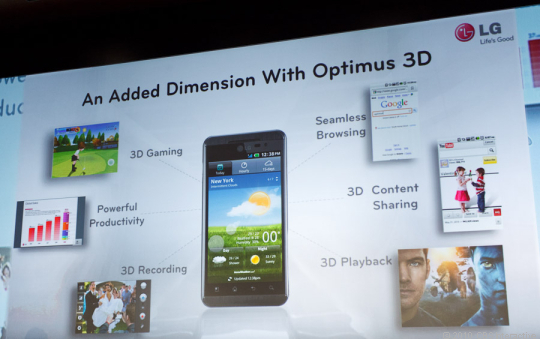3D-enabled smartphones won't do any better than 3D TVs


LG recently debuted the Optimus 3Dsmartphone at Mobile World Congress. As amazing as the handheld might seem, it raises many questions. Namely, do we even need or want 3D-enabled smartphones?
Of course, need and want are two very different things. I don't think anyone truly needs a 3D smartphone, and I'd be very interested to read an argument against that.
As for want, that is another story. Arguably, there are going to be at least some consumers who want a 3D smartphone. (Hey, there were at least a few units of the Microsoft Kin One and Two sold, and the LG Optimus 3D is definitely a more attractive device.) But how many consumers will truly throw down the cash for a 3D smartphone remains to be seen.
It also still remains to be seen how many consumers will even pay for a 3D TV, a device that is more arguably worth buying over a 3D smartphone. 3D has been around for a long time, but it really blew up on the scene at CES 2010. It was certainly a big point at CES 2011 this year, and it would be wrong to call 3D just a passing trend. But 3D TV sales have been rocky from the start.
Last June, the International Business Times reported that "only four percent of the TVs shipped to retailers in the first quarter of 2010 -- about 1.8 million out of 46.5 million -- were 3-D" and "the latest and greatest in television technology is likely to remain a niche product." One of the biggest problems cited at the time was the lack of at-home content available for 3D TVs. Hollywood is certainly trying to make up for this gap as quick as possible. (Even that Justin Bieber movie is being shown in 3D - don't ask why.) However, the amount of 3D content out there is still limited, and it will be even more limited on smartphones at this time.
In December, our sister site BNET found that many manufacturers were slashing 3D TV prices by up to 50%. Not for Black Friday or holiday sales, but rather because they simply weren't selling like the hotcakes they were expected to be.
Nevertheless, 3D TV sales are still growing. Panasonic had strong 3D TV sales at least once last year. The Futuresource Consulting research firm also predicts that 3D TV sales in the U.S. will likely double in the next year to five million units sold. So there is obviously some viable interest in 3D consumer technology.
One good part about the Optimus 3D's display is that it doesn't require the use of any extra glasses to view 3D video playback and stills. If it did, LG might as well give up now. However, we don't know the carrier subsidized price point, and that could really make or break the Optimus 3D. If it is somewhere around $199 or $299, then the Optimus 3D could go mainstream. But it won't be that low given the 3D tag gimmick that jacks up the price along with some reasonable price hiking given the advanced technology.
How well the LG Optimus 3D (and other future 3D smartphones) fares depends on the marketing as well. LG has already pointed out that the Optimus 3D can be used for capturing and viewing 3D stills and videos. In partnership with YouTube, those clips can be uploaded and shared online. However, none of that seems that original anymore given 3D point-and-shoots with HD video recording, and sharing such content also requires other users to have 3D monitors, digital frames, etc..
But before I even thought of 3D video playback, I thought of how this could be used for gaming. 3D smartphones could be marketed as competition for everything from Sony Ericsson's Xperia Play (a.k.a. the PlayStation phone) to the upcoming Nintendo 3DS. Since the Optimus 3D and similar smartphones are really targeted at adults, there won't (or shouldn't be) any controversy regarding vision development problems that have already plagued the 3DS. It would be a great platform for gaming mobile app developers and take smartphones in a new direction. If LG and other smartphone manufacturers decide to take this route, then we have something fresh with more possibilities.
To wrap up, 3D smartphones will probably start popping up more over the next year or two, but sales won't be that stellar. It's going to take a very long time for such products to get mainstream popularity - if that ever even happens. I'm more likely to save up for a 3D TV that requires active shutter glasses than buy an expensive smartphone just for its 3D display.